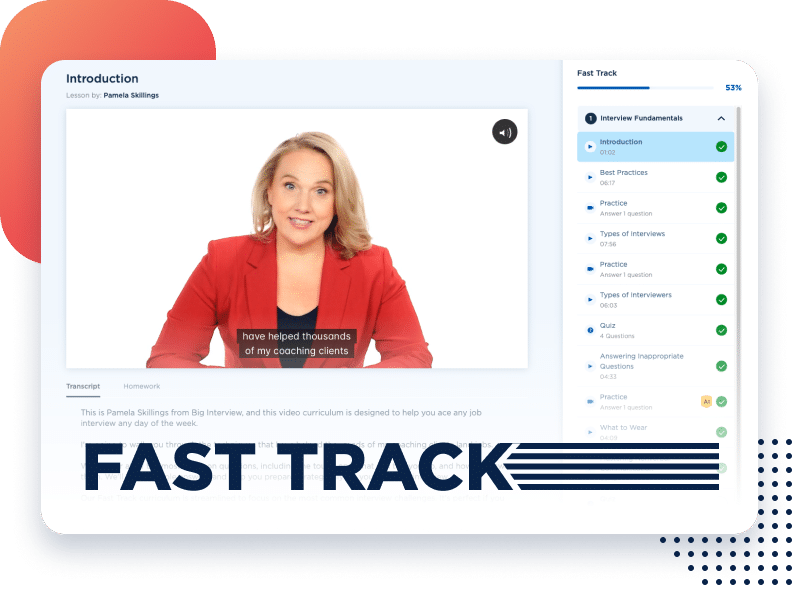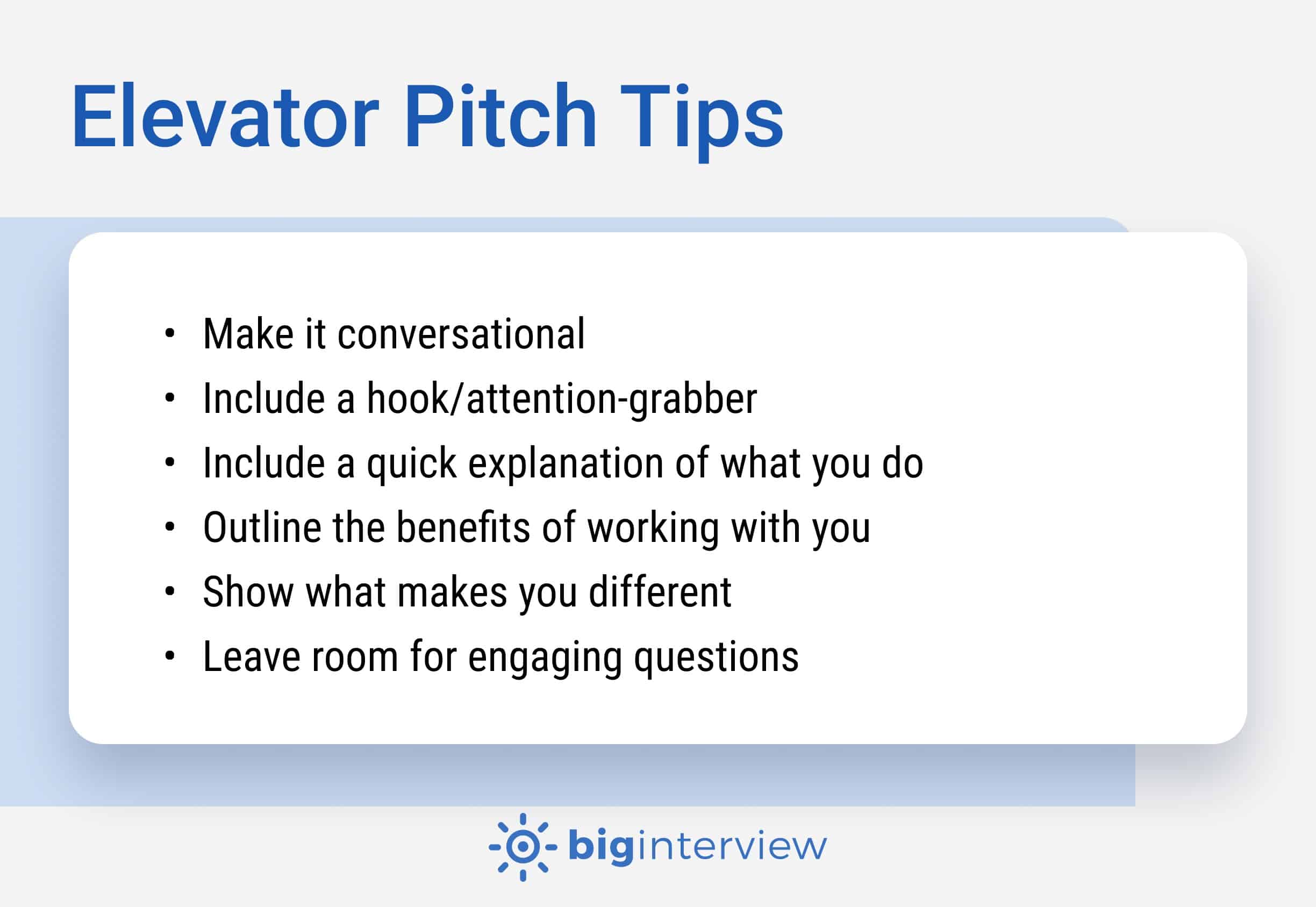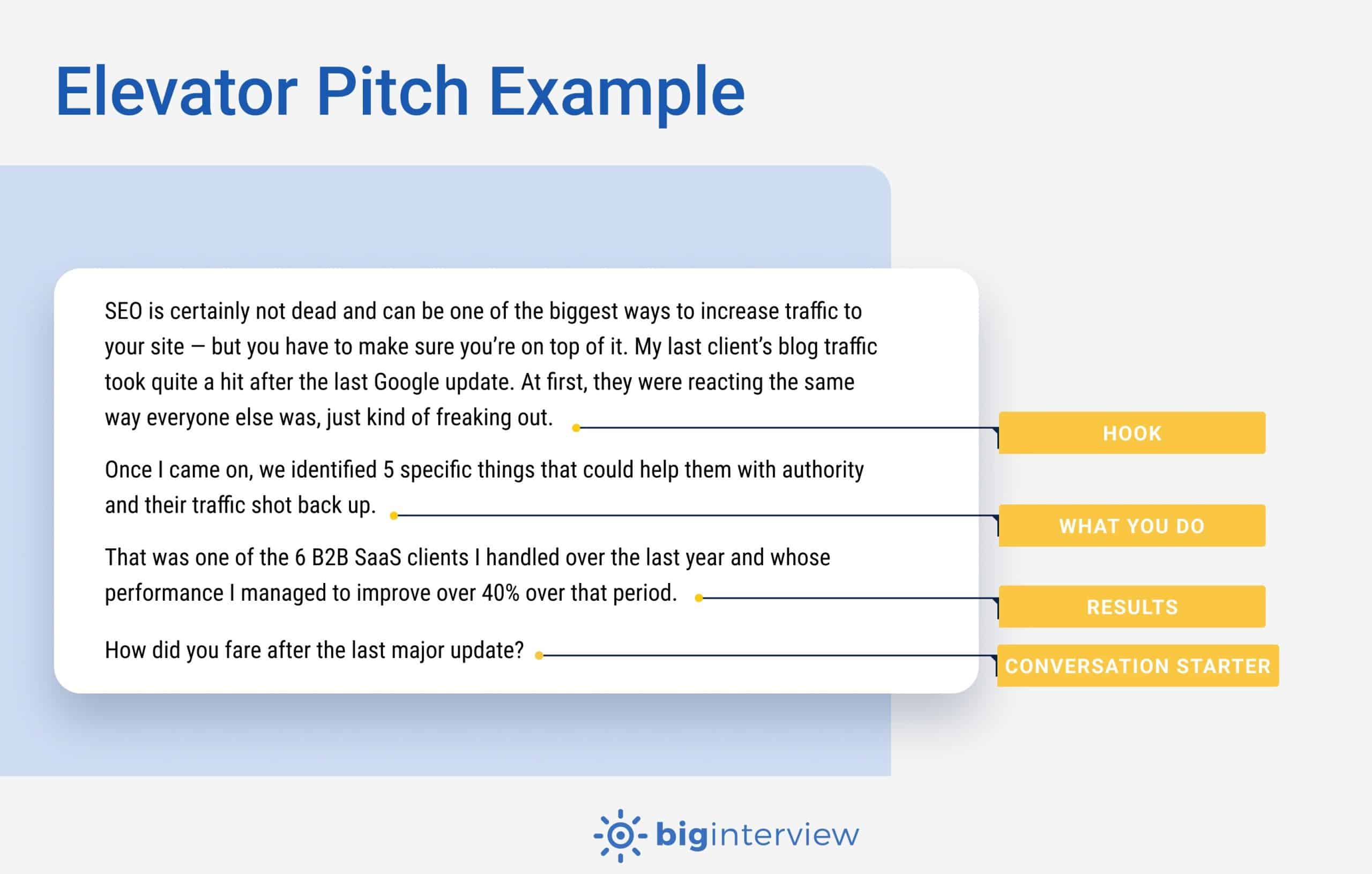You know the concept of an elevator pitch: a short, braggy speech you’re supposed to deliver in front of some big shot when you inevitably wind up in an elevator with them for 30 seconds.
Nowadays, it’s like an automated, generic LinkedIn message. It’s inflated, overly self-promotional, and incredibly outdated. This kind of approach just doesn’t resonate in today’s business landscape.
So what do you do if you need an elevator speech? You have hopes to sell yourself, land a job, get a client, or sell a product.
Well, you need to learn a better way to create and present an elevator pitch. It doesn’t require a lot of work, only a new angle.
In this article, we’ll talk about:
- What’s an elevator pitch and how to make it
- What a modern-day elevator pitch should include
- Elevator pitch examples for different situations
- The key to writing an elevator pitch that stands out

Don’t waste days compiling overused interview techniques. Get original answers to every single question you could expect.
Shifting the Perspective on Elevator Pitches
An elevator pitch or elevator speech is a 30–60-second long speech that informs listeners about you, what you do, and why it’s relevant to them — whether you’re trying to sell a product, services, or yourself as a candidate for a job.
You can use it to quickly introduce yourself in a job interview, at a job fair, during conferences, networking events, or other semiformal job-related gatherings.
But like we said, the standard elevator speech is slowly becoming outdated because people make it sound salesy and robotic.
This is why there’s a shift of perspective: the modern-day elevator pitch should be conversational, natural, and focused on human connection and authenticity. Otherwise, it might not have the power you’re expecting.
You should still introduce yourself, state what you do, what your mission is, and hint at how someone could benefit from that. But your main goal is to get the conversation started, so both parties (you and the person you’re speaking to) can exchange ideas and see if there’s space for collaboration.
How to Create an Elevator Pitch: General Template

Before we begin, we’d like to point out that this article will walk you through the basic structure of an elevator pitch. Then it’ll show you how to adjust it for different purposes (for a job interview, a networking event, and other job-related social gatherings).
We’ll also provide specific examples based on different situations.
Here’s what the general structure of such an elevator pitch looks like:
A “hook” or an attention-grabber
Finding a relevant topic, a common pain point, or an interesting question could be a casual, natural conversation starter. This makes for a perfect hook or an attention-grabber for an elevator pitch.
From there, you can gently steer the conversation in the direction of your expertise and create an inviting atmosphere for people to share their experiences with you.
For example: Imagine you’re attending a seminar/conference about Google updates and how they affect content marketing. You can start a convo by mentioning an interesting initiative you took regarding content update best practices, and how it helped you keep the traffic during turbulent times.
You can expand then, mentioning what you do and how somebody could benefit from that. Potentially, a decline in traffic is someone’s pain point, and that person would be interested in what you have to say right away.
You could start a conversation by asking: “How did you fare after the last major update?” It’s a nice way to put them first and show curiosity about their situation.
Then, you could say something like “My last client’s blog traffic took quite a hit. At first, they were reacting the same way everyone else was, just kind of freaking out. Once I came on, we identified 5 specific things that could help them with authority and their traffic shot back up.” This would grab their attention and give them something to relate to. Plus, it would present you as the solution to the problem, and they would be more than interested to hear about the 5 ways to increase traffic.
Which brings us to our next step.
A quick explanation of what you do
In this part of your elevator pitch, you can speak more about your work and how you solve different pain points.
It shouldn’t be bragging, but an honest, realistic story about your relevant experiences. If you can back them with hard data (maybe one key accomplishment, because you need to be short), even better. You can also mention some of your biggest clients, your mission and vision, or any other relevant detail.
The space for questions
Every good elevator speech will leave enough room for the person you’re speaking with to ask questions. Perhaps they’ll ask for more details about your expertise and company. That would be the perfect opportunity for you to elaborate and show how you could potentially solve their problems and contribute to their success.
Perhaps they’ll ask for recommendations, be it for software, strategy, or people. That’s a nice way to start building relationships.
Or, someone might straight up ask you if you could help them because they’re facing the same problem, and then the case is closed. You “sold” yourself during the elevator pitch purely because you were able to strike up a valuable conversation and provide value.
The questions you ask
You can ask questions in your elevator pitch! We’re moving away from sales-dudes-bragging pitches. People don’t want to listen to the monologue you learned by heart and recited to five people in the room. They want authentic conversations now.
Use the opportunity to ask relevant questions to keep the conversation going.
You can ask about how their company is dealing with the topic at hand, if they heard about a recent event in the industry, or anything else that would help you connect with and understand the person you’re speaking with.
✅ Pro tip: Elevator speeches don’t have to follow the same pattern. The more your elevator speech sounds like a natural part of the conversation, the more success you’ll have. If you can make your elevator speech a chameleon, perfectly blended with the rest of the talk, people won’t recognize that you’re “pitching” anything. What they will recognize is your expertise and authenticity, and they’d be drawn to you.

Elevator Pitch Examples for Different Scenarios
Elevator pitch examples for a job interview
If you’re looking for a job, you’ll likely hear “Tell me about yourself” in every interview. This is the perfect opportunity to bring out your elevator pitch and start a conversation.
Here’s how to create an elevator pitch for a job interview:
A recent graduate offering fresh perspectives and motivation to learn
A career switcher who shows transferable skills and eagerness to evolve
A seasoned professional highlighting vast experience and adaptability
Elevator pitch examples for a networking event
Notice how these elevator speech examples will be a lot more conversational and a lot less rehearsed than the ones for job interviews. You should be as natural as possible when networking — focus on creating a connection first and a collaboration second.
An industry expert pitching unique insights and records of accomplishments
An aspiring leader focusing on the vision and leadership potential
An eager student highlighting the desire to learn more and make valuable connections
Elevator pitch examples for social gatherings and other semi-formal situations
A freelancer discussing flexibility, bespoke solutions, and diverse experiences
A hobbyist-turned-professional conveying passion and talking about their unique journey.
An introverted specialist emphasizing deep knowledge and precision in specific areas
Elevator Pitch Examples: Popular Opinion vs. Expert Advice
The internet is full of all kinds of advice — terrible, alright, and some that’s actually pretty solid. Let’s see if popular opinion moved away from seeing elevator pitches as highly structured, salesy, learned-by-heart pieces of text to deliver.
Zak7062 from Reddit said:
“I’m better at writing software than I am at writing elevator pitches” is what I usually go with. Usually, it gets a laugh and is a decent icebreaker that gets me more time to talk to them.
Career expert comments:
If the occasion is not too formal, this is the perfect icebreaker that will set a positive tone right away and start the conversation in the right direction. My immediate reaction would be to inquire more about this person’s coding skills, so I guess the hardest part of their job is done. But bear in mind this is just a hook, an ice-breaker, and not a real elevator pitch. So make sure to prepare at least a few bullet points describing your skills and the value you’d bring to their company. It’s cool to have such a nice ice-breaker, but you need to follow up with something substantial.
From ConsulIncitatus:
“My job is to make us look good and I do that by measuring results and improving them. That’s also good for the company. I’m the ears and mouth for my teams and occasionally the brain. I believe in servant leadership. I clear the path for my technical staff to build our vision for our products. I focus on their growth and that in turn grows us.”
Career expert comments:
One might argue that this is a nice overview of the duties of this person. But not me. There are 6 pieces of general information here that don’t reveal anything about the person’s skills and ability to accomplish results. Everyone who has a job has to measure results and improve them.
This, if heavily edited, could be the middle part of an elevator pitch where a person briefly explains what they do and their key skills.
In that case, the person would have to narrow down their choice of information. If they want to highlight they’re result-oriented, they need to pick an example of when they improved poor performance and back it up by % or $. If they believe in servant leadership, they need to quickly elaborate the principles. And so on.
Bottom line: Pick one or two key things/values/principles/achievements and prove them. Don’t list generalizations — you’ll risk blending in with every other candidate.
From Gordon Miller on Quora:
A mentor of mine taught me “a pitch is complete not when nothing else can be added, but when nothing else can be taken away.” Another mentor told me “It is all about the ONE THING. You need to figure out what the one thing is.”
Career expert comments:
This is a nice way to look at it. I’m not saying you should focus on only one thing in your elevator pitch, but having a differentiator, a single thing that makes you different and potentially better from the competition is a nice thing to build your pitch around. Everything else you add should complement that differentiator, prove your worth, and hint at how you can help others who have the same problem.
Tips to Make Your Elevator Pitch Stand Out
Let’s see how you can make your elevator pitch more fun and engaging.
Personalize your pitch to show your unique value
A generic elevator pitch, the one you’d learn by heart and recite to anyone you meet, would blow your chances because it wouldn’t be relevant or valuable to the person you’re speaking to.
That’s why an elevator pitch needs to be personalized.
Creating a new elevator pitch for every person you’re speaking to makes no sense. But coming up with a nice basis and then adjusting the details each time might work pretty well.
If you know in advance who you’ll be speaking to, make sure to research their company so you’re in the loop with their initiatives and potential pain points. Then, highlight your specific achievements that directly relate to the company’s needs. Identify their pain points and address how your skills and experience could be the solution.
✅ Pro tip: If you don’t know who you’ll be speaking to, try to ask questions while you speak (if the situation allows it), or personalize the pitch to the company they work for.
Here’s a story my friend told me. One of her professors, who was also a hiring manager for Mondelez, often manned booths at career fairs. He said he used to hear thousands of bland elevator pitches with students listing their accomplishments, each similar to the previous one.
The ones who actually stood out always knew something about the company. He gave an example of one guy who started a conversation about Mondelez’s sustainability efforts in hazelnut production. The guy talked about how he was passionate about that and pitched some other ideas of ways they could improve these processes.
So even though the guy didn’t know who he would be speaking to, he made his elevator speech relevant by researching the company, obtaining important info, and adding it to the speech, along with additional ideas on how to improve the processes.
Keep the pitch conversational
Nobody wants to hear about you assisting in optimizing synergistic solutions for seamless integration in the tech ecosystem. They don’t understand what it means and they don’t care.
You need to keep your pitch conversational to hold the listener’s attention. By not sounding robotic and rehearsed, you’ll be more relatable and interesting to talk to. You’ll stand out by being memorable and authentic.
Plus, you’ll create a space for you and the person you’re speaking with to build a real connection and see how you can help each other.
How to keep it conversational:
- Avoid formal language or complex and vague terms.
- Use storytelling in your pitch
- Engage the listener: ask questions and create a dynamic discussion
- Pay attention to your tone and pace of speech
Highlight the benefits of working with you
When appropriate, highlight the benefits of working with you or your company, not just your skills or what you do in general.
Having sharp skills is great, but people probably want to know how you can use those skills to help them.
Try to address the why by bringing up unique points about yourself, highlighting your strengths, and mentioning your key achievements. Make sure those achievements are somehow connected to the industry/role/pain point/challenge/goal of the person you’re speaking to.
If you can prepare in advance and do some digging on the person’s company and challenges, even better.
Summary of the Main Points
- It’s important to move away from the old-school, salesy elevator pitches that make you boring and robotic.
- Nowadays, elevator pitches need to be authentic and conversational.
- Be aware that there are differences between an elevator pitch for a job interview and an elevator pitch for seminars, conferences, meetups, and any other job-related occasions.
- Your ideal elevator pitch should have a hook or another kind of an attention-grabber.
- It also needs to explain what you do and what’s in it for them.
- It should create a dynamic conversation where both you and the person you’re speaking to can ask questions.
- Keep your elevator speech conversational, personalized, and make sure to highlight the benefits of working with you.
_____________________________
Need a hand? There’s 3 ways we can help:
- Learn how to turn job interviews into offers. (Rated 4.9/5 by 1,000,000 users)
- Learn how to answer “What Can You Contribute to the Company?”
- Read about how to handle interview anxiety
Big Interview Newsletter
Twice a month, get 3-5 tips from Career Expert Pamela Skillings to find your dream job and grow your career. 5 min read.
FAQ
How long should my elevator pitch be?
30–60 seconds. It should be enough for you to get your key points across and start a conversation. This makes it suitable for most networking situations.
Do I need to write my elevator speech down?
It’s not mandatory, but it might help during the initial elevator pitch brainstorming session. Writing down different elevator pitch ideas and versions will give you clarity and structure. It might also help with setting up your arguments. You could adjust, rearrange, add, or remove ideas until you get the perfect version. Plus, having a written pitch makes it easier to customize for different situations. You can adjust it based on the audience, occasion, the context of a conversation, and similar.
What is the objective of an elevator pitch?
To succinctly communicate key information about your expertise, capture attention, build a memorable impression of you, and initiate conversation, opening the door for exploration of partnerships and opportunities.
Are there any famous elevator pitch examples?
Steve Jobs’ elevator pitch to John Sculley back in 1983 when Sculley was still at Pepsi: “Do you want to spend the rest of your life selling sugared water, or do you want a chance to change the world?”
Airbnb’s early pitch was interesting too: “Book rooms with locals, rather than hotels,” hinting at their unique selling point — connecting travelers with locals who provide authentic lodging experiences. That’s Airbnb’s one thing, their differentiator.
What’s a good example of an elevator pitch for someone with no experience?
If you have little to no relevant experience, you can focus on your enthusiasm, potential, and transferable skills. Show enthusiasm about the field, industry, or company, showcase potential by bringing up a relevant accomplishment from the academic field, volunteer work, or internship, and highlight how you could use key transferable skills to contribute. Make sure you pick the transferable skills relevant to the speaker, depending on their company, industry, or the type of role you’re discussing. You can also demonstrate your enthusiasm for the role/company by researching and pitching interesting ideas (like that Mondelez example we mentioned above).
What to say in my elevator pitch if I don’t do anything unique and am just a solid employee?
If you don’t have a particular achievement or a unique role, you can still emphasize your hard work, reliability, work ethic, and ability to contribute. Being a solid employee is quite a desired skill and should be highlighted. Additionally, you can quantify your work to prove it. Using a number to back up your claims will spice your pitch up. For example, you could say, “I truly believe that hard work and reliability are the keys to success in this job. I’ve been working for ABC Auto for the past 5 years — I’ve never showed up late and always gotten my work done on time. My boss once told me: ‘Whenever I ask you to do something, I know I’ll never have to worry about following up.’ It’s my favorite compliment I ever received.”
